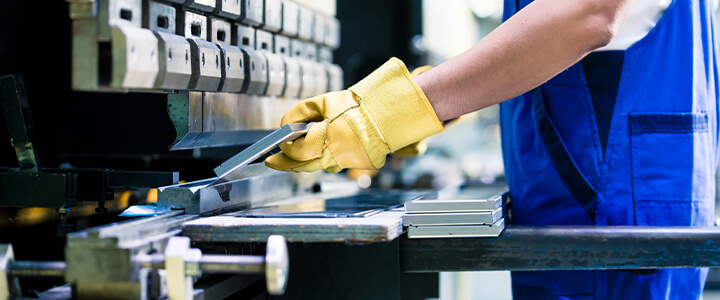- HOME
- FA Camera/Lens
- RICOH manufacturing DX Practical Lab
- Mistake proof factory with Poka-yoke!

RICOH manufacturing DX Practical Lab
Mistake proof factory with Poka-yoke!
Introducing Methods and Case Studies to Prevent Human Errors.

Despite careful intentions, humans are prone to making mistakes. In the manufacturing industry, it is vital to have a system to prevent mistakes (human errors, inadvertent mistakes) from occurring, and measures to detect when mistakes have been made to prevent defective products from leaking out. In this column, we present the fundamentals of Poka-Yoke, explaining its various types and some effective techniques for application.
What is Poka-yoke? Basic Concept

“Poka-yoke” involves the addition of mechanic systems and devices used in manufacturing processes to prevent unintended mistakes. Mistakes can lead to defective products and cause work-related accidents, so counter measures are a must for manufacturers.
For example, SD cards and SIM cards cannot be inserted into slots when they are placed oppositely since the shape of the cutouts are different on the left side and right side. In this situation, manufacturing lines may use molds (jigs) that prevents cards from being placed on the wrong side as much as possible to prevent mistakes from occurring.
In processes where it isn’t possible to physically prevent defective products from being produced, it is necessary to prevent such products from being passed on by notifying the workers whenever a mistake is made, using “an alerting noise” or “an alerting light”.
Read more in the article below.
What is Poka-yoke? Easy-to-understand explanation of how to create an mistake proof factory.Types and Methods of Poka-Yoke

There are several types of Poka-Yokes, which can be categorized as follows according to their means and purposes.
- Detection method
- Purpose method
- Timeline method
Here are the characteristics of each specific methods.
Detection method
In this method, Poka-Yoke can be applied to the following groups.
Identification type (color-coded, IC tag, sensor, image recognition)
This method allows you to identify any mistakes made, without any direct contact to the product required.
For example, by installing color-coded labels, workers may swiftly recognize parts and other items by looking at their labels. Workers will no longer need to read any descriptive papers to identify where a certain item is stored, making the process much easier.
Though, even with the use of such method, human errors usually cannot be prevented entirely. Therefore, in factories that handle a numerous number of parts, either IC tags, barcodes or scanned images of the parts are utilized to identify certain items. In addition, weight sensors may be introduced for item recognition and sorting.
IC tags are an item which recognize items through radio waves, without requiring direct contact to the item. By using a specific reader, it scans the silhouette of the item, allowing you to detect any errors immediately. In addition, you may switch through multiple different sensors depending on the item you want to inspect.
By install IC tag readers, sensors, and image recognition systems to your line, we may prevent mistakes such as workers forgetting to scan barcodes.
Alarm type (alarm, sensor)
When an abnormal mistake occurs, an alarm may be effective to notify workers. You may also let a worker know whenever they pick up a different part by accident with the use of alarms.
Jig type (guide pin/stopper)
Jigs ensure the correct placement and orientation of assembly parts by physically preventing incorrect positionings. If the set part is in an incorrect position, the guide pin won’t fit, and subsequent processes will be impeded. Using correct jigs are essential to prevent errors.
However, in a small-quantity, high-mix production plant, the jigs themselves may vary and managing those various jigs becomes as crucial as well. Selecting the wrong jig may lead to errors, so it is recommended that you utilize IC chips and other means to manage them carefully and reliably.
Purpose method
In this method, Poka-Yoke can be applied to the following groups.
regulation
To prevent errors, you may introduce a regulation system. For example, if a wrong part is set, the tools used in the next process will be stopped and the parts will be locked. This method stops defective items from progressing to the next process, preventing the outflow of defective products.
Caution
A buzzer or flashing light is employed to signal workers when an abnormality like a faulty product or incorrect part is identified. To effectively alert the worker, it is crucial to make sure that either the alarm is loud enough to catch attention, or if the flashing light is set in a position where workers may easily see.
Timeline method
In this method, Poka-Yoke can be applied to the following groups.
Preventive
Preventive measures are essential for Poka-Yoke. Preventive measures are based on the premise that workers may make mistakes, and even if mistakes are made, defective products shall not be produced, or if they are produced, they shall not be leaked. Process designs based on this concept are called mistake proof designs.
For example, by changing the colors of left and right parts, which are easily mistaken for each other, or by slightly changing the shape of the parts, you may prevent confusion among the workers. Mistake proof designs are also important to prevent industrial accidents.
Onset time
It is important to introduce ways to immediately detect defective products whenever they have been assembled in the work process. By removing defective products before they proceed to the final process, the outflow of defective products can be prevented, and man-hours spent on the unnecessary shipping may be cut down.
Specifically, defective products may be detected by image recognition systems and optical sensors. You may also install alarms and flashing lights to notify workers of defective products, but for an even more powerful measurement, it is recommended to create a system that prevents the defective items from proceeding to the next process.
post-occurrence
The post-occurrence inspection process aims to stop defective products from being released. Through image recognition, visual completion and pre-shipment inspection, defective products are removed from shipping lines. The final inspections before shipping serve as the last line of defense against shipping defective products.
Procedures for introducing Poka-Yoke.

Procedures to implement Poka-Yoke includes the following steps.
- Identifying the issues
- Standardization of work content
- Using of jigs and tools
- Measuring effectiveness and improving processes
Let's look at each of these procedures in detail.
1. Identify the issues by checking the situation
Human errors, or mistakes, can be succinctly characterized by phrases such as "often overlooked," "sometimes mistaken," "varying in execution”, “difficult to teach” and so on. Before implementing Poka-Yoke, it is essential to thoroughly assess the situation and to pin down the source of the problem.
2. Standardize work content
The inconsistency in work procedures among individuals makes it challenging to detect omissions, potentially resulting in errors. Work that is performed by skilled workers tends to become idiosyncratic, and when the person in charge changes, variations in quality and errors are likely to occur. Therefore, we shall standardize work content to achieve both consistent quality and absolute poka-yoke.
3. Using jigs and tools correctly
Poka-yoke may be implemented through jigs that do not accept wrong parts during processes and tools that stop workers if the work process is being conducted incorrectly. Poka-yoke that do not rely on the workers, or their proximity are highly reliable and effective.
4. Measuring effectiveness and improving processes
Evaluate the impact of Poka-Yoke on defect reduction by comparing the incidence and sources of defects before and after implementation. If the verification reveals that the countermeasure is not effective, consider alternative methods to guarantee success. For even greater effectiveness, consider adding additional steps or improving the fixtures by repeating the verification process.
Three advantages of implementing Poka-Yoke

Advantages of implementing Poka-Yoke include.
- Reduction of defective products
- Increased productivity
- Preventing Occupational hazards
Each of these benefits is described in detail below.
Reduction of defective products
In the manufacturing industry, the occurrence and outflow of defective products must be prevented to prevent unnecessary damage to the company's credibility and to cut down significant costs. Poka-Yoke directly prevents the occurrence and outflow of defective products, protecting the reputation of the company.
Increased Productivity
Once defective products are produced, it takes a great deal of time and money to prevent their recurrence. If defective products could be prevented by Poka-Yoke countermeasures, man-hours can be reduced and more time can be spent on the production of good products, thereby improving productivity.
Preventing Occupational hazards
Imagine a worker’s finger inadvertently getting caught while operating a press machine. It could lead to a serious, occupational hazard such as the loss of a finger. To prevent such hazards, a poka-yoke system where the press machine only activates when both left and right fingers are simultaneously pressing the start button, may be introduced. In this way, poka-yoke also helps prevent work-related accidents.
Please refer to the following article for examples of successful poka-yoke countermeasures.
Countermeasures for human errors ~Introducing Poka-Yoke case studies~Keys to Prevent Human Errors

To prevent human errors, you shall pay attention to the following points.
- Understanding the concept of Poka-Yoke.
- Considering the cooperation within the production field
- Establishing a system
Each of these points will be explained below.
Understanding the concept of Poka-Yoke
Design a system that both physically prevents mistakes and promptly detects and halts the production of defective items. It is important to understand that although error prevention measures which rely on workers like double-checking and check sheets can be helpful, they alone cannot eliminate mistakes completely.
Considering the cooperation within the production field
If a process is added as a countermeasure against human errors, the significance of the process must be communicated to the workers beforehand to obtain their cooperation. In addition, opinions from the factory floor may lead to such discovery like, “these specific parts are hard to distinguish,” or “It is easier to proceed this process when done in the opposite order”. In addition, uncooperative workers may result in the production of defective items by since they may neglect certain processes. To enhance the impact of Poka-yoke methods, it's crucial to focusing on education and corporation within the factory floor.
Establishing a system
Develop a system equipped with poka-yoke, such as jigs, AI-based image recognition systems, and systems that stops the process whenever a mistake is made. It is important to introduce a poka-yoke system that does not rely on human efforts.
Let's improve operational efficiency with Poka-yoke!
The most efficient method to prevent mistakes is to implement a mechanized system that do not rely on human efforts. A system to prevent mistakes should be incorporated along with training of occupational safety and health among the workers.
Unlike other visual inspection cameras, RICOH's camera focuses on inspecting assembly quality during and after the work process. Our camera will support your factory by checking for similarities, completeness, work order, and missing parts automatically. It can be introduced without any PC required and is suitable for companies seeking for a simple digital inspection solution.
Work Inspection Camera RICOH SC-20
